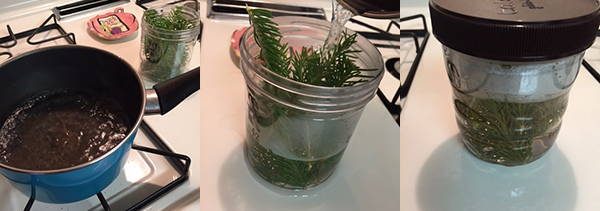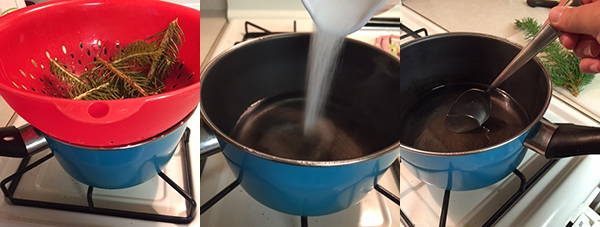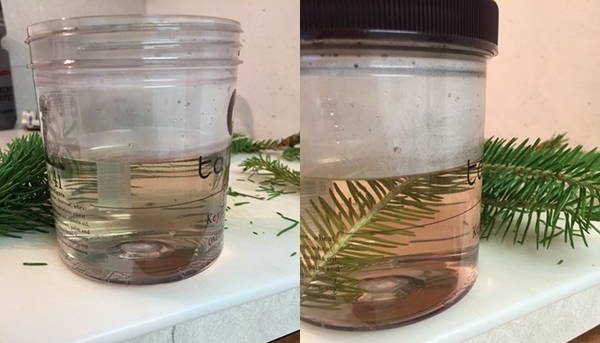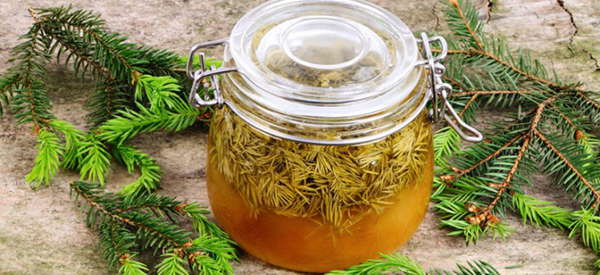Homemade pine syrup is a great natural supplement that promotes overall good health and disease prevention. It’s also a simple, easy way to flavor cocktails, teas, and savory dishes, especially during the winter months. It will bring a unique lemony herbaceous component to any application. All pine needles are edible, so gather some clean branches and in just a few simple steps and only three ingredients, fresh pine syrup will be ready to enjoy!
How to Make Pine Syrup at Home in Under 40 Minutes
- The first step is to flavor the water that will be used to make the syrup. To do this, roughly chop a few small branches (about a handful) of pine needles to a more manageable size, and place in a sealable container.
- Next, bring one cup of water to a boil, and pour over the pine needles. Seal the container and allow the needles to steep for at least 30 minutes, and no longer than twenty four hours.

- Once done steeping, strain out the pine needles from the water and discard them. Place the water in a small sauce pot along with one cup of sugar. Stir with a whisk or spoon while bringing mixture to a simmer. Once it has reached a simmer, allow to cook for about one minute.

- Lastly, allow for syrup to cool before refrigerating. May be stored for about one month.

How to Fully Benefit From Your Homemade Pine Syrup
In addition to flavoring and sweetening drinks, homemade pine syrup may have a wide array of health benefits. Primarily, it was dissolved in tea and used as an anti-inflammatory and a way to help decrease high blood pressure. Later on, it was found that it may be helpful as a remedy for relieving some symptoms of respiratory illnesses. Specifically, it can be taken to help ease the cough from bronchitis and asthma, as well as the common cold and flu. Vapors from boiling the buds can be used for clearing up nasal congestion, lessening a cold, and clearing skin.
Related: Making Raw Apple Cider Vinegar at Home
The syrup is also a good source of calcium, and one teaspoon per day has been shown to improve bone health and prevent osteoporosis. It also contains a high amount of vitamin C and A, which will help strengthen the immune system and may prevent illnesses.
Additionally, homemade pine syrup may also stimulate digestion. When applied directly to the skin it may reduce muscle soreness and nerve pain. While pine remains to be a safe, natural way to potentially improve overall health, it is important to keep in mind that these health improvements are still being studied and may not work the same for everyone.
Other ways to incorporate the nutrition from pine syrup is through cooking. From a culinary standpoint, it adds an interesting minty and fresh tasting twist to sauces, roasts, marinades, stews, breads and broths. It would pair well with chicken, beef, or fish.
Using the syrup as a sweetener in cocktails and other beverages is another great use—it would add an interesting spin on lemonades, iced teas, mojitos, mint juleps, or an old fashioned. It can even be added simply to morning hot coffee or tea as a vehicle for a great daily supplement. Young needles tend to work best for cooking—they are lighter in color, softer, and have a milder flavor.
Making pine syrup at home is an easy process that yields a very useful ingredient. Whether it is simply a way to put a Christmas tree to good use, take a supplement, help make a cold more manageable, flavor the perfect soup, or make a comforting tea in the winter, pine syrup is an excellent way to incorporate both good flavor and good health into a daily routine.
You may also like:
How To Preserve Beef in Glass Jars
Arizona Farmer Accidently Discovers Trick to Turn Air into Water (Video)
Dipping Candles the Old-Fashioned Way















Hold on a minute…
You state that this is healthy…
Yet, you add an entire cup of sugar…
Utter foolishness!!
Any nutritional benefit gained from the micro amount of pine extract is totally negated from the heinous metabolic yo-yo you’ll experience from the sugar.
A whole cup?!
Seriously, unless one is literally starving, refined sugar has no place in anyone’s diet. Even then, if there is ANY option other than the sugar, eat it before going with the refined sugar…
Get current on your info, before spewing this nonsense.
If you value your health and pancreas, dont add the sugar… avoid it.
Nuts!
Ok, so now that you have “ranted”, how about offering some alternative recipes or suggestions……
The author didn’t say drink a cup of this everyday…..
Get a life, or since you seem ” so Enlightened” why not start your own “better than anyone else’s” newsletter/blog.
I for one enjoy the info here and find most of it very practical and usable. When the crap hits even a know it all like you might find yourself doing things differently than you do now. Whole foods probably won’t be around for you to get your alternative sweeteners.
It’s SYRUP. You use it very sparingly. The instructions even say “one teaspoon a day.” Our bodies actually need sugar..I know, I suffer form occasion low blood sugar.
U are so right ! I am making syrup of spring pine spruces(May) ….with buckweed honey …white rafinated sugar is bad for u …I am using this syrup for colds along with thyme ,plantago lancesis and pulmonaria …it is powerful …
Hi Agy, would you mind to tell me how do you exactly use honey instead of sugar? Do you also boil the honey like sugar?
Ok, you have 1 cup of this….what’s the recommended dosage for blood pressure, for instance.
Can you sue stevia in place of sugar?
Thanks
Sugar works as preservative….Stevie not …u can use raw honey
Since you call it “pine syrup” I’m wondering why the pictures all show fir needles and not pine needles?
Somehow, it makes me suspicious……..
And does it make a difference if you use sugar pine, lodge pole pine or Ponderosa pine?
Firs are a type of pine. There are over 200 varieties. And…..they all belong to the “Pinaceae” family.
Sugar pine has sweet spruces… and u need less sugar …use honey enstead
Actually the fir tree is part of the Abies family. A simple google search will confirm
You list some of the vitamins, but do you happen to know the vitamin K content? People on blood thinners have to be very careful with this or it can affect their clotting times. Thanks!
Vitamin K is fat soluble, not water soluble. So this solution made of pine and sugar water will not contain vitamin K.
can you actually use Pine? As Boone said it’s Fir or maybe even Spruce. Need to see it up closer. Big difference!
There appears to be an issue here. The pictures actually do not show Pine Needles, as it is brought out. So, do you use the real [pine needles? Or Spruce, etc? Also, would it be better to use honey rather than sugar? For health sake.
Why do the pictures not show pine needles?
Do any of yall know anything about trees…the fir,spruce,long leaf,lob lolly and the Google Ole southern are all in the same class just look different ,they are all pines
At the first of the article Anne said “all pines needles are edible”. She also said” to use the young sprouts as they are more tender and are not so strong. Yall Need to attend a reading and comprehension class and give the lady break. She is only trying to help those that need it and want.
I agree Rob. Maybe before people get on here and bash the author they should do a little research. the Douglas Fir tree is actually a member of the pine family just as a couple of people on here yourself included, have pointed out.
And if someone insists on bad mouthing what is being said, I agree: have an alternative, intelligent suggestion. Yes, we may be able to get something better for ourselves than sugar but some people do still use sugar. If a person doesn’t like or want to use sugar, good for you. Don’t use it but don’t be the “food police’ for everyone else.
Learn to live and let live, offer possible alternative suggestions, and be polite. No one is forcing you to read this article or make and use the syrup.
Beata Sint,
Wayne
Thank you Wayne, live and let live? Mine your own biscuits? We must come from a different age. I could rant, but it only hurts, I’m tired. Love you all, times are gonna get tougher, so must we with ourselves. Thanks again Wayne.
I think that people have been lied to and misled so many time on the internet that they fear taking things at face value, and honestly, its ALWAYS good to verify… However, not so good to be rude to the author about it… NOBODY is responsible but you for your experimentations, kids, so ALWAYS verify any information you intend to act upon. IF nothing else, it will teach you due diligence, and will often teach you to also respect the authors of how-to-info packets! IE, if you believe this is doug fir, LOOK up DOUG fir to see if the tips are edible! Dont ASK the author, because if they are wrong, they are going to defend their position, likely r/t not believing they are wrong. IF you think its hemlock, LOOK IT UP, dont challenge the author. Impolite, Children. IF you think its fir not pine, look up pinus, and keep looking things that apply up, till you KNOW. To tell an author they are wrong is to tell the author “I cant trust you!” RUDE if you are on their page and not on your own.
I cannot believe the rude comments on here, if you don’t like it don’t read it. I for one enjoyed this post. I make syrup with Scots pine, fir, and norway spruce every spring and summer. I also use the young green cones along with the needle tips. I do want to point out that some pine needles are not safe for syrup, for example ponderosa pine. Definitely identify the tree you will be harvesting from before consuming. Thanks for the post.
Maybe the author means “evergreen trees” instead of pine trees? Just a thought.
That is spruce. not pine….
Yup no pine, Fir and spruce is pictured as being processed into syrup. You can tell it’s fir by the way the needles go left and right. And the Spruce needles go all around .
I made the most delicious pinecone syrup from ponderosa pine, I am now in the process of making a ponderosa tincture and some more syrup from the needles.
Later I will get some blue spruce from my neighbor for more tincture. I am also going for a juniper berry cough syrup made from juniper berry tincture and ever clear.
I also noticed the fir when it says pine. Some here argue that fir is part of the pine family. But they are not the same thing. Their benefits have some differences even if they have similarities. I don’t think there is anything wrong or impolite to mention that this is fir and not pine. The recipe is still good and useful since fir is good also.